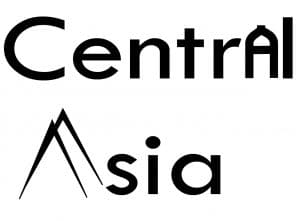Khiva
Khiva
Khiva is the only fully preserved (though heavily restored) ancient city on the Great Silk Road. Khiva was founded about 2500 years ago and is now an open air museum, which is sometimes even referred by Uzbeks as the “eighth wonder of the world” as it offers an enormous amount of architectural monuments recognized in the UNESCO World heritage site list (Itchan Kala – the inner city).
Khiva is also one of the once grand cities of the Khoresm oasis area in the southern delta of the Amu Darya, south of the Aral Sea, just 10 km north from the current border of Turkmenistan and where the sandy Kyzyl-Kum desert begins.

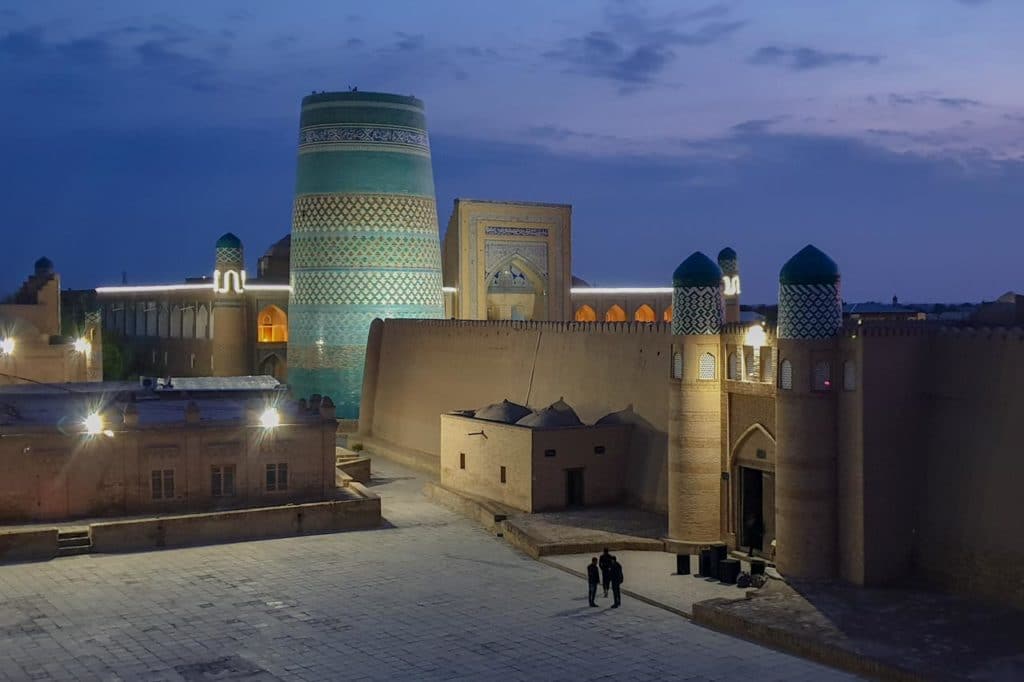
This walled, first ancient and later Medieval city is one of the most popular destinations in Uzbekistan by both domestic and foreign tourists. Khiva was a vital Silk Road stop-off where the trading of camels, carpets, coffee, tea and concubines thrived. Khiva’s heyday as a a major silk road stop between China and Europe was between the 2nd century BC all the way to the 13th century.
Khiva really is a place where the imagination of a visitor starts to run wild and it is easy to see how the life could have been hundreds of years ago in a magnificent walled city surrounded by the desert. It is also one of the three major silk road cities of Uzbekistan together with Bukhara and Samarkand.
History of Khiva
Khiva has been destroyed and rebuilt seven times as most of the ancient Central Asian cities. The town has been seized by Arab invaders, conquered by Mongolian ruler Genghis Khan, eventually overthrown by Amir Timur – whose empire extended from Iraq to India and finally taken by Russia and became a part of Uzbekistan after the collapse of the Soviet Union. What you can now see in Khiva is mostly from the late Medieval times.
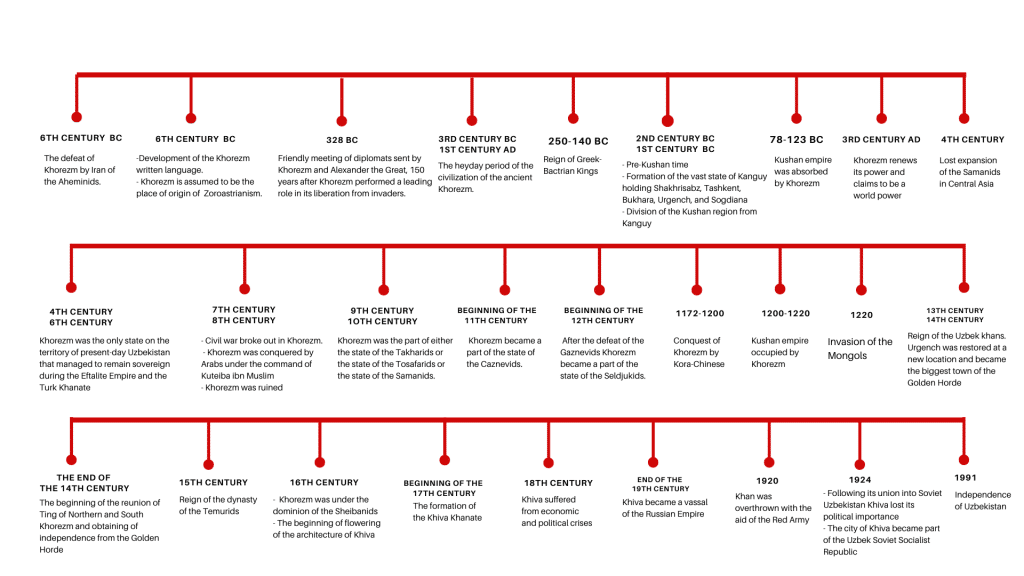
Khiva sights
Ichan Kala
Khiva is most known for its Ichan Kala walled city which has had the status of a museum already since 1967 when the Soviet Union recognized the value of the architectural heritage inside the city walls, especially from the point of view of tourism. Some say though that the formerly rebel city of thieves and slave traders was tamed by the Soviet rule into a showcase city without a soul but in any case is definitely on the bucket list of every Uzbekistan visitor.
Most of the people living inside the walled area were driven also out but there are still about 2 000 locals living inside the walls from the total of 40 000 Khivans. You can’t purchase property here as the land can be passed down only through families and if you wish to decorate your garden you need permission from Unesco. Nevertheless, Khiva and Ichan Kala remain as the most homogenous collection of old architecture in the Islamic world.


The inner walled city occupies an area of about 30 hectares and has almost rectangular form. Khiva was located inside the limits of the Ichan-Kala fortress until the 16th-17th centuries. The city was surrounded by a strong clay and brick wall with a height reaching up to 8-10 m, with 6-8 m thickness and a length of more than 2200 m. Built from adobe mud bricks, the oldest remaining sections of the walls date to the 5th century AD, though much of what you see now is of far later (17th century) construction. The strongest sections were added by Arang Khan, son of Anusha Khan, in 1686-1688. The Ichan-Kala’s strengthened walls, with semicircular towers on its perimeter, provided reliable protection for the Khiva City at the time.
There used to be a lancet gallery with holes and towers on the upper part of the wall and the gates were located at the center of each of the four parts of the Ichan-Kala walls. The guards posted here would have been heavily armed and monitored closely everyone and everything entering and leaving the city. The gates look as historic as the walls but the ones you see today were rebuilt in the 19th and 20th centuries.
Ichan Kala has a stunning amount of sights to be seen. There is a risk of getting exhausted of the monuments and architecture that the tourist will face inside. Below we present most of the sights but for sure we have missed something. There is enough to be explored for 1-2 days at least and more outside the walls.
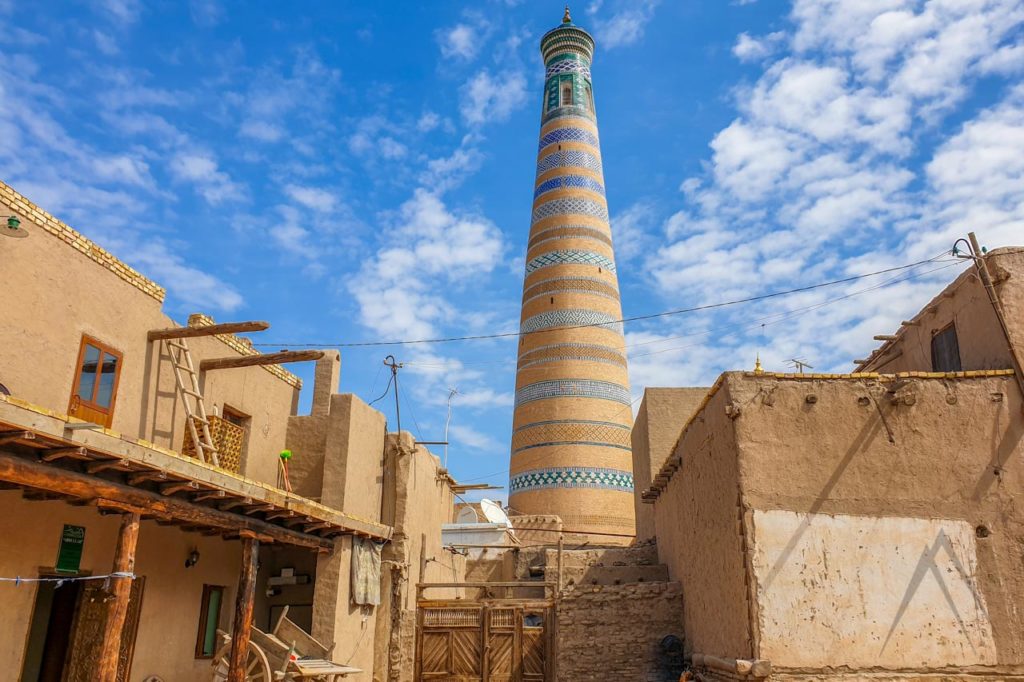
Khiva Ichan Kala (old city) Gates
Khiva city wall has 4 main gates from each cardinal direction. Each gate is different and gives a nice glimpse on how it must have been to ente and exit a Medieval city.
Ata-Darvaza (West Gate)
The Ata-Darvaza Gate (Father Gate) was destroyed in 1920 in order to build a road and was restored only in the 1970s. Most visitors enter the city through this western gate. This is the only gate where you need to pay the entrance fee to enter the walled city area.
Bakcha Darvaza (Northern Gate)
Bakcha Darvaza (Garden Gate) is the Northern gate of Ichan Kala with double-sided guardrooms. It was the place of taxation for the caravans arriving from Urgench.

Tash Darvaza (South Gate)
Tash Darvaza (Stone Gate) (1830-1840), the arrival point for caravans from the Caspian area, where twin stairwells lead to a first-floor viewing platform. It was restored during the reign of Allah Kuli Khan receiving a guardhouse and a customs office.
Palvan Darvaza (East Gate)
Polvon Darvaza (Warriors’ Gate), is the gate where royal announcements were declared back in the days. It dates from 1806 and was once the entrance to the famous slave market. In the 17th-18th centuries this place held the ancient gates in which the Khan’s prison was located. Under Iltuzar Khan (1804-1806) and then under Alla-Kuli Khan the gates were later restored anew.
Eastern gate is also the gate one will be using when entering the city from the new Khiva railway station.
Madrassas and Mosques of Khiva
Khiva was focused on developing religious education and religious debate and its wealthier residents were competing to beat each other by building larger, richer and more elaborate madrassas. Eventually, at the beginning of the 20th century, there were 65 madrassas in Khiva and 54 of them within the city walls. In addition there were nearly 100 mosques in the city, highlighting Khiva’s significance as a religious center.
Khiva Slave Trade
The wealth of Khiva has a partly dark past. Until the 19th century, Khiva was well known for its brutal slave trading market. Each man materially owned a personal slave to work his fields. Russian men were always in demand as workers, although Persian women were highly prized for the harem.
Khiva Minarets
Juma Mosque and Minaret
Juma Mosque has an impressive feeling with the the dim insides and the scent of time-worn wood. The roof is supported by 213 unique columns of elm wood, some of which date back to the 10th century. You can feel like standing in a forest of elegantly carved, curvaceous trees. Most columns are from the 18th century when the mosque was repaired after earthquakes.
Kalta Minor Minaret
Kalta Minor Minaret is a unique minaret completely covered with glazed tiles and majolica but also unfinished.
Islam Khodja Ensemble
The Islam Khodja ensemble contains the tiniest madrasah and the highest minaret of Khiva.
Kheyvak Well
Kheivak well is the holy of holiest in the history of Khiva. It is told that the city of Khiva began its existance from this well. Information about the city dates back to the 5th century BC and a legend says that the water from this well had an amazing taste. The well was accordingly dug by the order of Shem, the son of the biblical Noah. Today Kheyvak well is located in one of the courtyards of the northwestern part of Ichan Kala, not far from the city wall.
According to the historians, a special clay was used in the construction of the Kheivak well that was mined from 2 km away in the territory called Govuk-Kul. Nowadays, there is a large lake in this place and the quality of the clay, still mined there, is excellent. There is even a belief that all the clay for the construction of Ichan-Kala was taken from the same place, where the prophet Muhammad mined it during the construction of Medina. Since then, the lake has been considered a holy source.
Kunya-Ark Fortress
Kuhna Ark or Kunya Ark (“Old fortress”) is the Khiva’s rulers’ fortress and residence, first built in the 12th century by Ok Shihbobo, then expanded by Muhammad-Erenk Khan (1687-1688) in the 17th century. Kunya ark was also the place where the Khan’s mosque, supreme court, reception (kurinysh-khan), powder mill, arsenal, mint, registry, harem, kitchens, stables, guardhouse and other structures resided.
Zendan Prison
Zindan means darkness in Persian and refers to the fact that most Central Asian jails took the form of underground pits. However, that was not possible in Khiva due to the high water table. Zindan city jail (1910) was a special place for executions which lies outside the main gates. It is equipped with chains, flails, and a series of pictures re-creating cruel tortures and executions. The square in front of the Zindan drew frequent crowds for the public- executions of the kind witnessed by Vambery.
Originally the prison consisted of three smallish rooms, an outer guard room (which is now destroyed), a jail for tax offenders, and an inner room for those accused of committing more dangerous crimes. Prisoners were never kept detained for very long: tax offenders were held until relatives had paid off their debts while the more hard-core prisoners were chained for seven days with a water and toilet break just once a day. If their families did not come up with the demanded money by the end of this period the prisoner would simply be taken out and executed.
Pakhlavan Makhmoud Mausoleum
The turquoise dome of the Pakhlavan Mahmud is the largest dome in Khiva. Pahlavan Mahmud was a poet, philosopher and wrestler and even was considered a patron of a healer throughout Khiva, Iran and India.
Anusha Khan Bath house
Baths have played a significant role in culture, society and urban civil architecture in Central Asia for a very long time. The bath house of Anush Khan in Khiva are the earliest architectural monument of the city eventually are of particular value as an example of architecture in the Middle Ages. The Anusha-khan bathhouse is located next to the Ak-Mosque and was constructed in 1657. The bathhouse was under continuous repair and rebuilt repeatedly.
It is believed that Anusha-Khan was developed as a part of this Ak-Mosque in honor of the Anusha-khan by his father the Abulgazi-khan (1644-1664) the governor and the well-known historian. Like many structures of the ancient world, the baths were built for centuries, impressive with the thoughtfulness of water supply, heating and sanitation systems. Anusha-khan bathhouse is a semi-underground construction with several premises and an underground heating system. The bases are deep in the ground to allow the heat to remain longer. Domes of the bathhouse with its light vertical holes on top are only visible outside. Like other eastern bathhouses, it consists of a lobby and premises for undressing and bathing.
The baths of Anush Khan are vital because the technologies used in construction are quite progressive for the middle of the 17th century. Ancient structures are not inferior to modern baths in terms of convenience and efficiency.
The baths complex is preserved in good condition and continues to serve as a health center in Khiva.

Tash-Khovli Palace
Tash-Khovli (Tash-Hauli or Tach Khaouli) translates as the “Stone courtyard” and it is the name of the most new Khiva palace that was built during the period of Allakuli-khan (1825-1842). Tash-Hauli is located in the eastern part of Ichan Kala and it was the political, public and trading center of Khiva of its time. Inside a visitor can enjoy very fine blue tile decorations along with the other beautiful details of Khorezm architecture.
Allakuli Khan Caravanserai
The large market area called Allakuli Khan Caravanserai, dedicated for the trade of grains, fruits, soaps and candles, was built in the eastern part of Ichan-Kala in 1833 by the order of the current Khan. There were also a series of small trading houses and a place for the slave trade in the adjacent site. The reason to build a new caravanserai was the development of trade relations with Bukhara, Iran and especially with Russia.
While looking at the Allakuli caravanserai, it is not hard to notice that it is architecturally close to a madrasah with two floors of small rooms and the only real difference is actually the wide entrance meant for trade. The foreign merchants used to stay in the upper floor while their goods were safely located in the first floor rooms. This means that it is one of the latest examples of the beautiful Khorezm madrasa architecture, even though it was not built as a madrasa.
The caravanserai had also to be fit into Ichan-Kala that was already fully surrounded by its wall at the time, so they destroyed a part of the town wall and constructed the building with its side as a part of the city wall, its facade facing the bazaar square outside it. The still standing roofed bazaar was added later to the facade entrance of the caravanserai’s northern edge near the east gate of Khiva. The Allakuli site is easy to spot as it is at the eastern end of the main route inside Khiva and next to the white mosque.

Khiva Dishon Qala
Dishon Kala (Dishan Kala) is the Khiva old town, outside the inner city walls. The outer city has persevered a lot lesser amount of its old buildings compared to Ichan-Kala, inside the inner walls. The reasons for this are the devastating invasion of the Iranians and simply the passage of time without much effort of residents to restore and renovate the ancient structures.
The Soviet times destruction of old homes in the area has also played a role in the current look of the outside walls and the area between the walls. Only some parts of walls (northwest and south from Ichan Kala) with gates and few architectural monuments have survived but the area itself is less restored and offers a glimpse to the true life of modern day Khivans with occasional old buildings between the housing areas.
Dishon Kala is a lot less decorated with the narrow dirt roads and people living in the streets and hanging their clothes to dry on the walls and between the houses. No doubt that the Uzbek authorities will soon realize that some tourists wander off from the designated area and the looks of the nearby areas will also be lifted. This is already happening in the areas nearby the train station in the currently or previously empty areas.
Our advice is to wear your older shoes and to explore the areas west and southeast from the Ichan kala where some of the most authentic guest houses are also located. Nurullaboy Saroyi inside Dishon Qala is also a must see place just 200 – 300 meters northwest from Ichan Kala NW corner.

Khiva's Outer City Wall (Dishon Kala)
The outer walls that protected Dishon Kala were originally built under the rule of Allakuli Khan in the middle of the 19th century to protect the city from the attacks of the Turkmens. According to the order of the governor, every resident had to work 12 days a year for the construction of the wall without compensation. The number of working residents has been estimated being about two hundred thousand and with the abundant working force, the wall was completed within about three years.
The length of the outer fortification was originally about 6 kilometers, the height of the walls reached 8 meters and the thickness in the most fortified places 6 meters. There are longer intact sections of the wall south and northwest from Ichan kala and three gates have survived: Kosh-Darvaza, Gandimyan-Darvaza and Khazarasp-Darvaza from the ten original gates.
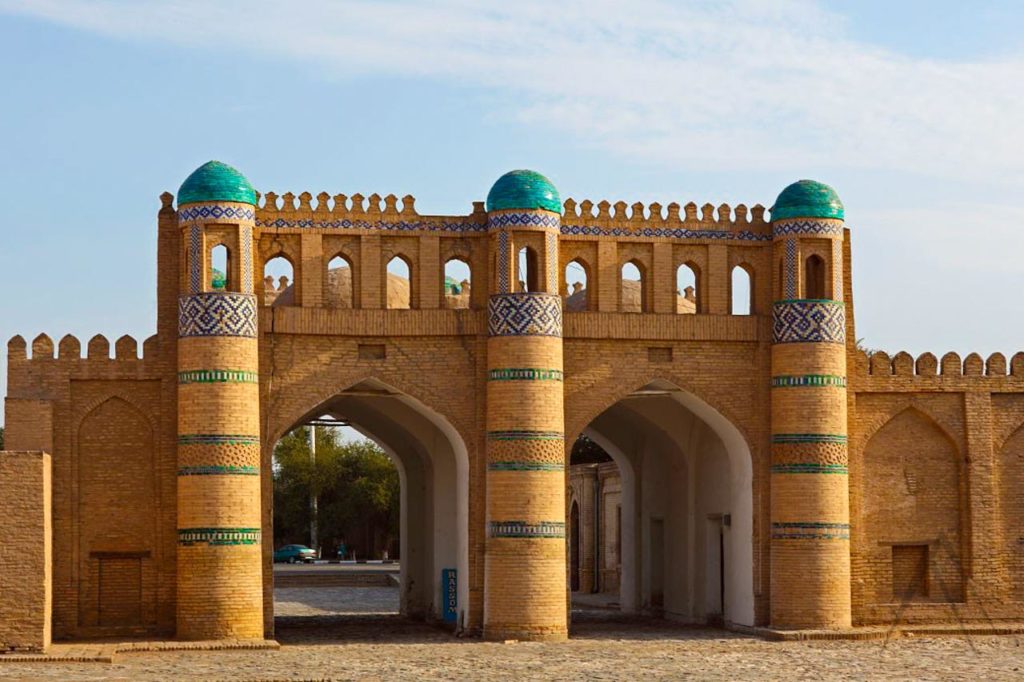
Kosh Darvoza
The Northern gates “Kosh Darvoza” were established in 1912 and included three narrow cylindrical towers connected by arched passages with crenelated railings. The central facade of the gate is decorated with mosaics and small domes with azure tiles.
Khazarasp-Darvaza
Khazarasp-Darvaza was built in the middle of the 19th century together with two wide observation towers. Between the towers there is a large arched passage with railings decorated with teeth.
Gandimyan-Darvaza
Gandimyan Darvaza was built in 1842, but then demolished and restored according to old drawings only in 1970. The gate has two narrow cylindrical towers with an arched passage, above which is a gallery with finials in the form of teeth. The domes of the towers are decorated with blue tiles.
Summer Palaces of Khiva Emirs
Nurullaboy Palace
Nurullaboy Saroy palace is little bit outside the Ichan Kala inner wals, in the northwestern part of Dishan-Qala. The palace was established by Muhammad Rahim Khan II for his son and heir Asfendiyar-khan and was built between 1906-1912. The Nurullah-Bai palace resembles Sitori-Mohi-Khosa Palace in Bukhara with a diverse mix of Khivan and European architecture and the insides especially remind a European palace rather than a palace in Central Asia.
The palace includes the reception hall of Asfendiyar-Khan, courtyard, living quarters and madrassah. The reception was built in the European or Oriental style to accommodate foreign guests. The palace consisted of seven rooms and in the construction was utilized the force of German colonists particularly in the decoration of the ceilings, windows and parquet. Decorative ceramic tiles were manufactured in Saint Petersburg.
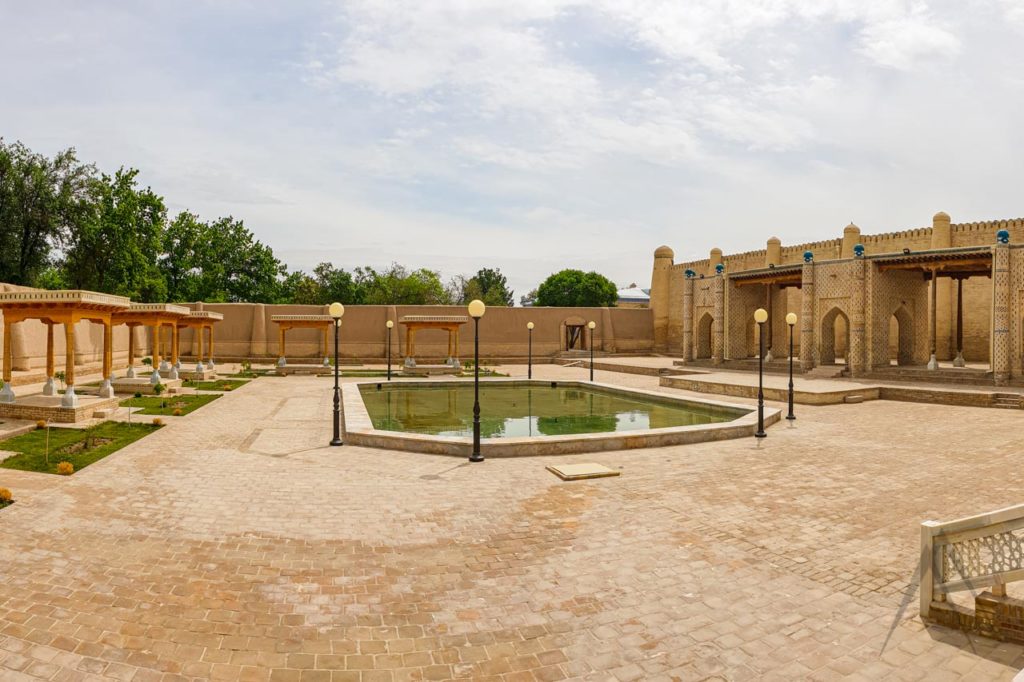
Qibla Tosabog Palace
Kibla Tozabog is another one of the Khiva Khans summer residences about 2 km southwest from Ichan Kala It was built by the Kungrat dynasty in 1897 by the command of the Khiva Khan Muhammad Rahimhan II who was the eleventh ruler of the Kungrat dynasty.
The Qisla Tosabog complex includes three yards of various sizes. Each of them is surrounded by a large two-storey houses that are decorated from outside with carved wooden columns. Nowadays the palace accommodates a health center where one can spend weekend and taste the dishes of Khorezmian cuisine.
KHIVA Tours
Travel to Khiva
Plane
There are two daily flights from Tashkent to Urgench taking 1 h 20 min. There are also straight international flights from Russian cities like Moscow and Saint-Petersburg.
The Urgench Khorezm Airport airport is located about 40 km northeast from Khiva and there are regular very inexpensive trolleybuses traveling between Khiva and Urgench taking about 1 h and of course the inexpensive Uzbek taxis taking you straight to Khiva in about 30 mins.
It is also possible to reach Khiva by plane through Nukus.
Train
Regular daily (Soviet) trains operate from Tashkent to Khiva taking about 16 h. Along the way, they stop at numerous stations like Samarkand, Navoi and Bukhara. There are also the modern Afrosiab train connections that are a lot faster and stop in fewer stations. There are also night trains leaving in the evening and having you in Khiva by the morning.
Khiva train station is located less than 1 km east from Ichan Kala. You can get there easily by walking along a street sided by handicraft and other souvenir shops. Book your tickets in advance here.
Bus / Taxi
The closest intercity bus station to Khiva is located in Urgench. You can get to Urgench by taxi or trolleybus. That said, Khiva is quite far from other major Uzbek destinations: Tashkent 990 km, Samarkand 690 km, Bukhara 450 km, Fergana valley 1300 km, Shahrisabz 1020 km and Nukus 180 km. Therefore bus is not usually your first choice of travel to/from Khiva.
If you are traveling also in Turkmenistan, Khiva is not far from Konye Urgench and the numerous sights there.
Traveling by rails is the ideal way to travel between the largest cities of Uzbekistan and the same applies also to Khiva that has a new train station which also serves the high speed Afrosiab trains. A pro tip is that is that you can have access to a VIP lounge like in an airport if you are willing to use few dollars or euros for coffee and snacks. It provides you with better toilet facilities and nice sofas to wait for the train.
There is a newly quite nicely built shopping haven between the train station and Itchan Kala to catch the tourists while making their way towards or out of the walled city.

Sights & Destinations near Khiva
Page updated 14.2.2022
